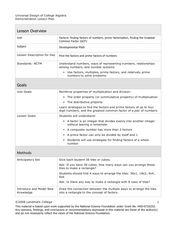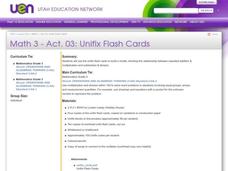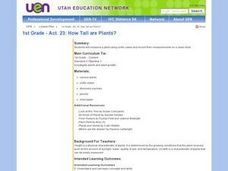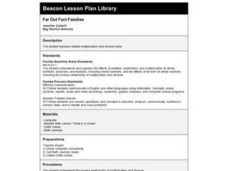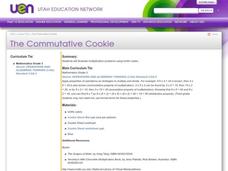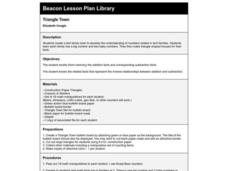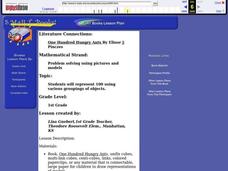Curated OER
What to Do with Leftovers
Second graders solve real world division story problems using unifix cubes. They read "A Remainder of One" and discuss the concept of remainders. They solve the division problems first with the cubes and then write the problem and answer...
Curated OER
Making Patterns - Create, Analyze, and Predict
Fourth graders practice making patterns using Unifix cubes and identify, analyze, and determine rules for describing numerical patterns involving operations and nonnumerical growing patterns. They also find an example of a pattern in...
Curated OER
Multiplication Strategies and Writing Story Problems
Third graders model multiplication problems using Unifix cubes. They compute and solve problems involving addition and subtraction of 3- and 4- digit numbers and basic facts of multiplication and division. They practice mental math...
Curated OER
Find the Factors and Prime Factors
Show the class how to find the factors of numbers. They use a variety of strategies, including unifix cubes, to find the factors of a whole number. This resource includes clear procedure to follow. Included are an anticipatory set,...
Curated OER
Exploring Multiplication and Division at a Party
Students solve multiplication and division problems using Unifix cubes. They explore multiplication and division through equal grouping of objects and sharing. Students discuss the task they completed and share how they completed the...
Curated OER
Symmetry with Manipulatives
First graders investigate symmetry in patterns by utilizing unifix cubes. In this pattern lesson, 1st graders practice creating patterns that are perfectly symmetrical no matter which way it's looked at. Students utilize...
Curated OER
Pizza Anyone?
Students, in groups, create models of pizzes and divide them, usin Unifix cubes, into fractions.
Curated OER
Unifix Flash Cards
Third graders are asked how multiplication, division, addition and subtraction are related. After being read part of a book, they work together to build a model between addition and multiplication. To end the instructional activity,...
Curated OER
Fraction and Decimal Garden
Third graders write fractions and decimals using unifix cube models and grid paper. They draw a garden using grid paper and label each section with the correct fraction and decimal to the tenths. This is a clever way to use manipulatives...
Curated OER
How Tall are Plants?
First graders measure a plant using unifix cubes and record their measurements on a class chart.
Curated OER
Fraction Card Shark
Second graders explain the relative size of fractions using symbolic and concrete representations. Groups of four students play a game which uses cards and unifix cubes. The game helps them get a visual understanding for the 'size' of...
Curated OER
Far Out Fact Families
Second graders explore related multiplication and division facts. They study the inverse relationship of multiplication and division and engage in a group discussion about families. They complete a web-based lesson plan which is imbedded...
Curated OER
"One Hundred Hungry Ants" by Elinor J. Pinczes
Young scholars identify arrays and write multiplication and division problems to match. They write their own multiplication book using arrays.
Curated OER
The Commutative Cookie
Third graders investigate the commutative properties of multiplication and focus upon the setting of cubes in the correct patterns to solve problems. They differentiate between numbers that have multiple factors and prime numbers....
EngageNY
Calculating Probabilities for Chance Experiments with Equally Likely Outcomes
Calculate theoretical probabilities and compare them to experimental probabilities. Pupils build on their knowledge of experimental probabilities to determine theoretical probabilities. Participants work several problems with the...
WakeGOV
Plastic Sight Words
Plastic math? Have young learners count and name the number of plastic items in their centers. Kindergartners match sight word cards to the number of plastics in a given group, while learning that plastics come in all different shapes,...
Curated OER
Triangle Town
Second graders create a fact family town to develop the understanding of numbers related in fact families. They learn each family has a big number and two baby numbers. They make triangle shaped houses for their facts.
Curated OER
Fraction Frenzy
Second graders identify fractions as part of a set. They explain concrete and symbolic representations of whole numbers, fractions, decimals, and percents in real-world situations. They complete a web-based cookie baking instructional...
Curated OER
Science: How Tall Are Plants
First graders investigate plant growth and examine what factors contribute to plant growth. They keep a class chart of plant growth and write about and illustrate their conclusions.
Curated OER
Even and Odd Numbers
First graders use patterns in order to identify and recognize even and odd numbers.
Curated OER
Sort It Out! Size It Up!
Second graders, in groups, estimate amounts in various jars. They sort each jar from least to greatest amount.



